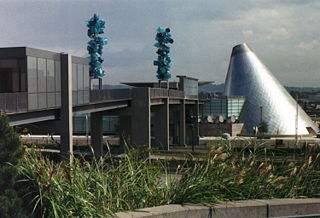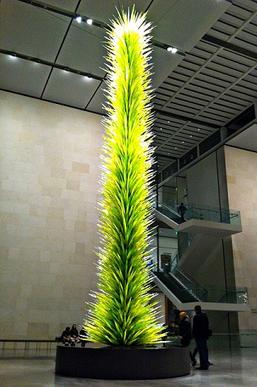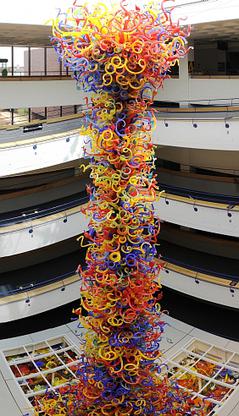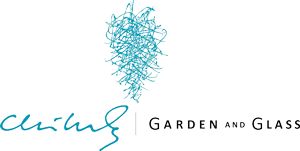
Dale Chihuly is an American glass artist and entrepreneur. He is well known in the field of blown glass, "moving it into the realm of large-scale sculpture".

A chandelier is a branched ornamental light fixture designed to be mounted on ceilings or walls. Chandeliers are often ornate, and normally use incandescent light bulbs, though some modern designs also use fluorescent lamps and recently LEDs.

The Museum of Glass (MOG) is a 75,000-square-foot contemporary art museum in Tacoma, Washington, dedicated to the medium of glass. Since its founding in 2002, the Museum of Glass has been committed to creating a space for the celebration of the studio glass movement through nurturing artists, implementing education, and encouraging creativity.
Pilchuck Glass School is an international center for glass art education. The school was founded in 1971 by Dale Chihuly, Ruth Tamura, Anne Gould Hauberg (1917-2016), and John H Hauberg (1916-2002). The campus is located on a former tree farm in Stanwood, Washington in the United States. The administrative offices are located in Seattle. The name "Pilchuck" comes from the local Native American language and translates to "red water" in reference to the Pilchuck River. Pilchuck offers one, two, or three week resident classes each summer in a broad spectrum of glass techniques as well as residencies for emerging and established artists working in all media.

Abravanel Hall is a concert hall in Salt Lake City, Utah that is home to the Utah Symphony, and is part of the Salt Lake County Center for the Arts. The hall is an architectural landmark in the city, and is adjacent to Temple Square and the Salt Palace on South Temple Street. The hall can hold up to 2,811 occupants.
Ed Carpenter is an artist specializing in large-scale public sculptures made of glass. His work can be found in conference centers, libraries, and airports.
Marvin Bentley Lipofsky was an American glass artist. He was one of the six students that Studio Glass founder Harvey Littleton instructed in a program at the University of Wisconsin-Madison in fall 1962 and spring 1963. He was a central figure in the dissemination of the American Studio Glass Movement, introducing it to California through his tenure as an instructor at the University of California, Berkeley and the California College of Arts and Crafts.

Dominick Labino (1910–1987) was an internationally known scientist, inventor, artist and master craftsman in glass. Labino's art works in glass are in the permanent collections of more than 100 museums throughout the world. Labino held over 60 glass-oriented patents in the United States.

Stanislav Libenský and Jaroslava Brychtová were contemporary artists. Their works are included in many major modern art collections, such as the Metropolitan Museum of Art and the Victoria & Albert Museum.

Dan Owen Dailey is an American artist and educator, known for his sculpture. With the support of a team of artists and crafts people, he creates sculptures and functional objects in glass and metal. He has taught at many glass programs and is professor emeritus at the Massachusetts College of Art, where he founded the glass program.

DNA Tower, a public sculpture by American glass artist Dale Chihuly, is in the Morris Mills Atrium of the VanNuys Medical Science Building, on the campus of Indiana University-Purdue University Indianapolis (IUPUI), which is near downtown Indianapolis, Indiana. It was commissioned for the Indiana University School of Medicine through a gift from an anonymous donor and was dedicated on September 30, 2003.

The Bridge of Glass is a 500-foot (150 m) pedestrian partially-covered footbridge spanning Interstate 705 in Tacoma, Washington. It was opened in 2002 as a gift to the city. The Bridge of Glass connects the Museum of Glass on the Thea Foss Waterway to the downtown and attractions along Pacific Avenue such as Union Station, Washington State History Museum, and Tacoma Art Museum. Together, these attractions make up an area of Tacoma described as "Museum Row." The Bridge of Glass was designed by Texas architect Arthur Andersson and is decorated with artworks by Dale Chihuly. Chihuly has described the Bridge of Glass as "the gateway that welcomes people to Tacoma." It is accessible and free to the public 24 hours a day, lighting up during the nighttime.

Lime Green Icicle Tower is a 2011 glass and steel sculpture by American artist Dale Chihuly. Housed in the Museum of Fine Arts (MFA) in Boston, Massachusetts, it has been on display in the Ruth and Carl J. Shapiro Family Courtyard since the 2011 exhibit "Chihuly: Through the Looking Glass". The sculpture proved so popular during the exhibit that the museum launched a fundraising campaign to purchase the piece.

The Union Passenger Station in Tacoma, Washington, United States, opened in 1911. It was listed on the National Register of Historic Places in 1974. It now serves as a courthouse of the United States District Court for the Western District of Washington. The distinctive architecture, dominated by a copper dome, is a landmark for the area.

Fireworks of Glass Tower and Ceiling, also known as Fireworks of Glass, is a blown glass sculpture installation in the permanent collection of The Children's Museum of Indianapolis located in Indianapolis, Indiana, United States of America. The tower sits on a glass base, a pergola ceiling, and rises through the center of the museum's spiraling ramp system. Created by Dale Chihuly in 2006, it is his second-largest permanently installed glass sculpture. Beneath the tower is an accompanying exhibit that describes the sculpture and the process by which it was made. The tower and pergola ceiling are two distinct accessioned objects in the Children's Museum's collection.

Chihuly Garden and Glass is an exhibit in the Seattle Center directly next to the Space Needle, showcasing the studio glass of Dale Chihuly. It opened in May 2012 at the former site of the defunct Fun Forest amusement park.
William Warmus is a curator, art critic, and author focusing on transparent media.
James Mongrain is a Seattle-area glass artist. He was educated at Moorhead State University in Minnesota, then studied glassblowing at Massachusetts College of Art and Design and the Appalachian Center for Crafts. Mongrain lives in Everett, Washington and operates a studio in Mukilteo at a former salmon smokehouse. He is considered one of the leading artists of the studio glass movement in the Pacific Northwest, and has unique mastery of Venetian goblets, combining the techniques of using a mold and blown glass on the same piece.

Fred Tschida is an American neon artist and professor of glass.
















